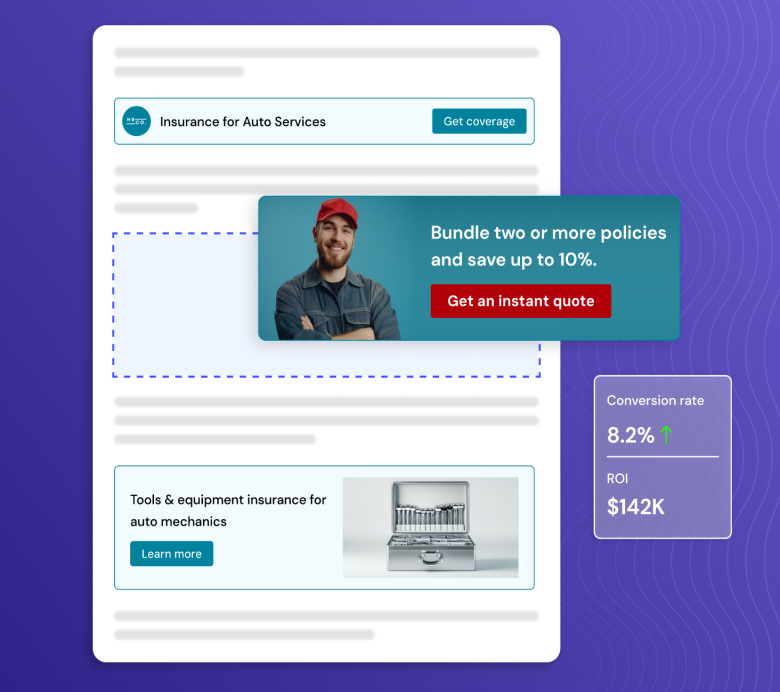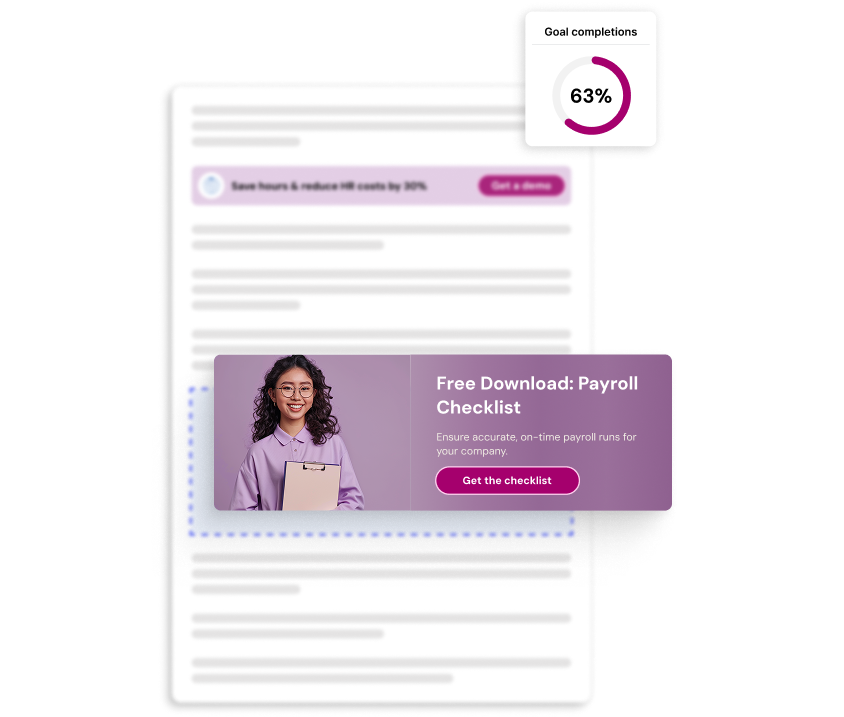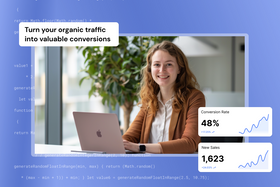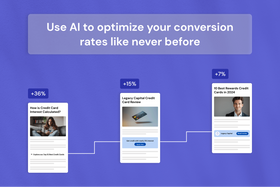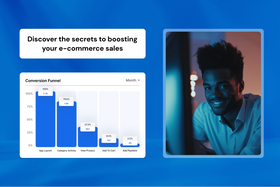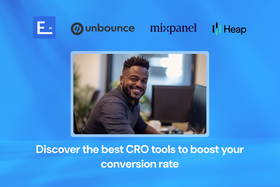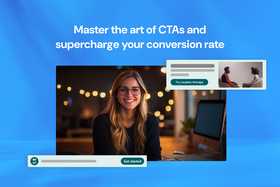Paid vs. organic customer acquisition: Here's why both are best
Discover why combining paid and organic acquisition strategies delivers the best results for sustainable growth.
Updated May 9, 2025

Getting new customers costs money, whether you're paying for ads directly or investing time in creating content. If you're like most marketers, you're constantly wondering if you're spending too much on ads or if your organic efforts will ever pay off.
Both approaches have their strengths and limitations. This guide compares paid and organic acquisition strategies, showing how they work best together rather than as competing approaches. You'll find practical ways to combine them for better results without breaking your budget.
Key takeaways
- Paid acquisition delivers quick results but costs more, while organic methods build lasting value with slower initial returns.
- Combining paid and organic methods creates synergy that maximizes ROI and provides stability through market changes.
- Sharing data between paid and organic efforts improves targeting, messaging, and overall campaign performance.
- Testing concepts with paid ads before investing in long-term organic strategies reduces risk and saves resources.
What is paid acquisition?
Paid acquisition is exactly what it sounds like: you pay money to get new customers. This includes any method where you directly spend money on advertising or promotions designed to bring potential customers to your business.
The main appeal of paid acquisition is speed—launch a campaign today, see results tomorrow. This immediacy makes it particularly valuable when you need to generate traffic quickly or want to scale rapidly.
» Check out these CRO best practices to turn traffic into sales.
Paid acquisition channels
There's no shortage of places to spend your marketing budget:
- Search engine advertising: PPC campaigns on Google or Bing that put your business at the top of search results for specific keywords.
- Social media advertising: Targeted ads on Facebook, Instagram, LinkedIn, or Twitter that reach people based on demographics, interests, and behaviors.
- Display advertising: Visual ads that appear on websites, apps, and social media platforms to build awareness.
- Influencer marketing: Partnerships with content creators who have audiences that match your target market.
- Affiliate marketing: Performance-based arrangements where partners earn commission for driving sales or leads.
- Sponsored content: Paid articles, videos, or podcasts that deliver value while promoting your product.
- Remarketing/retargeting: Ads that follow users who've already shown interest in your business.
Pros and cons of paid acquisition
Pros:
- Speed: Launch a campaign today, see visitors today—no waiting for organic efforts to mature.
- Scalability: Found something that works? Simply increase your budget to get more results.
- Precision targeting: Reach exactly who you want based on detailed demographic and behavioral criteria.
- Clear metrics: Easy to track exactly what you're getting for each dollar spent.
- Predictable volume: Maintain consistent traffic as long as you keep paying.
Cons:
- The treadmill effect: If you stop spending, you'll likely stop seeing results, which creates ongoing dependency.
- Diminishing returns: Ad fatigue sets in as markets become saturated and costs rise.
- Ad blockers: More and more users are filtering out your expensive ads.
- Rising costs: Prices typically increase over time as competitors bid on the same audiences.
- Trust deficit: People know when they're being sold to and may be skeptical of ads.
What is organic acquisition?
Organic acquisition means attracting customers without directly paying for each visitor or impression. Instead, you invest in creating value that naturally draws people to your business—like helpful content, community engagement, or simply having a product so good that people can't help but tell their friends.
The beauty of organic acquisition is that it keeps working for you long after the initial investment. A great piece of evergreen content might continue bringing in new customers for years.
» Discover the top safe ways to drive organic traffic in 2026.
Organic acquisition channels
Here's where you can focus your organic efforts:
- Search engine optimization (SEO): Making your website the answer when people ask Google questions related to your business.
- Content marketing: Creating helpful blog posts, videos, guides, or tools that address your audience's problems.
- Social media marketing: Building authentic connections through regular posting and community engagement (without paying to promote posts).
- Email marketing: Nurturing relationships with subscribers through valuable content and timely offers.
- Public relations: Getting media coverage because your story is genuinely interesting or newsworthy.
- Community building: Creating spaces where people with shared interests can connect around topics related to your business.
- Word of mouth: Delivering such exceptional value that customers naturally recommend you to others.
- Podcasts and webinars: Sharing expertise that positions you as a trusted authority people want to do business with.
» Explore SEO customer acquisition strategies to boost traffic and conversions.
Pros and cons of organic acquisition
Pros:
- Lasting value: That blog post from 2023? It could still be bringing in customers in 2026.
- Higher trust: People trust content they discover organically more than advertisements.
- Compound growth: Results typically increase over time as you build authority and a content library.
- Lower ongoing costs: Maintenance costs are minimal compared to paid channels after creation.
- Full-funnel presence: Reaches potential customers whether they're just researching or ready to buy.
» Check out these proven strategies to turn blog traffic into customers.
Cons:
- Patience required: Results take time, sometimes it can take months to see significant traffic.
- Content demands: Requires consistent creation of high-quality material.
- Unpredictable timing: Hard to forecast exactly when your efforts will pay off.
- Algorithm vulnerability: One Google update could affect your visibility overnight.
- Content saturation: Standing out gets harder as more competitors create similar content.
Paid vs. organic acquisition: Which is better?
The most successful businesses don't choose between paid and organic acquisition; they strategically combine them to create a system greater than the sum of its parts.
Why businesses should use both paid and organic acquisition
Here's why the either/or approach falls short:
- Different time horizons: Paid gives you immediate results while organic builds long-term assets—you need both for sustainability.
- Multiple touchpoints: Most customers interact with a brand 7-13 times before purchasing. This is also known as the Rule of Seven. Using both approaches creates more opportunities for these interactions.
- Risk management: Relying solely on paid leaves you vulnerable to cost increases; depending only on organic means the algorithm changes could tank your traffic overnight.
- Complete journey coverage: Different acquisition methods excel at different user journey stages.
- Data advantages: Insights from each approach strengthen the other, improving overall marketing performance.
» Want to understand your customers better? Learn how to create effective user journey maps + templates.
How paid and organic methods complement each other
The real magic happens when these strategies work as partners. Here's how:
- Message reinforcement: When someone sees your ads and finds your helpful content organically, it creates a powerful trust signal.
- Insight sharing: Your paid campaigns quickly reveal which messages resonate, informing your longer-term organic content strategy.
- Audience building: Use paid methods to quickly build an audience that organic efforts can nurture over time.
- Concept testing: Test headlines, angles, and offers with small paid campaigns before investing in creating full organic content pieces.
- Conversion path optimization: Retarget organic visitors with specific ads based on the content they've already consumed.
READ MORE: SEO vs. PPC: Which one should you invest in?
How to use both paid and organic acquisition strategies
Let's move from theory to practice with specific tactics for integrating these approaches:
1. Use paid advertising to boost organic content
Don't create separate assets for ads—amplify what's already working:
- Put ad budget behind your highest-performing blog posts or videos to extend their reach.
- Use search ads as a stopgap while working to improve organic rankings for valuable keywords.
- Create retargeting campaigns specifically for blog readers, offering related products based on topics they've read about.
This strategy is particularly effective for content that's already proven its value through organic engagement metrics.
2. Apply organic content insights to paid campaigns
Your organic content is a testing ground that can improve paid performance:
- Notice a blog post getting exceptional engagement? Create ads with similar messaging.
- Look at which search queries bring organic traffic and use those exact phrases in your ad copy.
- Check which subtopics within your content get the most comments or shares, then create targeted ads around those specific points.
Pro tip: This approach saves money by applying lessons you've already learned instead of paying to discover them through ad testing.
» Learn how to create content that converts.
3. Create multi-channel attribution models
Most businesses dramatically undervalue either paid or organic because they're not tracking how they work together:
- Track how customers move between channels before converting instead of only crediting the last touch, using appropriate attribution windows for each type of interaction.
- Look at which content pieces assist conversions even when they're not the final interaction.
- Analyze which combinations of paid and organic touchpoints create the highest-value customers.
With the proper attribution models, you'll often find that channels you thought were underperforming are actually playing a crucial role in the customer journey.
» Ready to optimize user journeys for conversion? Learn how multi-touchpoint attribution can help.
4. Develop retargeting strategies for organic visitors
Organic traffic often represents high-intent visitors who just need a little extra nudge. Here's what you can do:
- Create specific remarketing audiences based on which blog categories people read.
- Develop targeted offers for visitors who have consumed how-to content related to problems your product solves.
- Use email sequences tailored to the specific content topics that initially attracted each subscriber.
This targeted follow-up converts interest (generated organically) into action (prompted by paid), creating higher conversion rates than either approach alone.
» Need help with your retargeting strategy? Speak to an expert.
5. Coordinate content calendars across paid and organic
Strategic alignment multiplies impact:
- Time major content releases to support upcoming promotional campaigns.
- Create "content ecosystems" where ads, landing pages, blog posts, and emails reinforce the same core messages.
- Develop resource hubs that serve both SEO goals and provide depth for visitors coming from paid campaigns.
This coordination ensures potential customers receive consistent messaging regardless of how they first encounter your brand.
Measuring success across paid and organic acquisition
Without good measurement, you're flying blind. Here's what to track:
Key metrics to track
- Customer acquisition cost (CAC): Calculate this for individual channels and combined efforts to see the true cost picture.
- Lifetime value (LTV) to CAC ratio: This should stay above 3:1 for healthy growth.
- Assisted conversions: Track which channels start customer journeys even when they don't get final conversion credit.
- Channel velocity: Measure how quickly leads from different sources move through your funnel.
- Multi-touch conversions: Identify which combinations of channels produce the best results.
» Want to track the metrics that actually matter? Discover 10 essential conversion metrics for measuring cross-channel success.
Balancing your investment
The right mix depends on several factors:
- Your margins (higher margins can support higher acquisition costs)
- Growth goals (faster growth usually requires more paid spend)
- Competitive landscape (how expensive are keywords in your industry?)
- Sales cycle length (longer cycles benefit more from organic nurturing)
- Current brand recognition (lesser-known brands often need more paid support)
Pro tip: Review these factors quarterly to adjust your balance as your business evolves.
Stop choosing sides: Build an integrated acquisition engine
The paid vs. organic debate misses the point. These approaches aren't competitors—they're teammates with different strengths. The most successful businesses integrate both into a coherent strategy, sharing data and insights to create a system where each amplifies the other's effectiveness.
Finding the optimal balance isn't a one-time decision but an ongoing process. As your business evolves and market conditions change, continue measuring results and adjusting your approach accordingly.
» Learn how to reduce customer acquisition cost.
